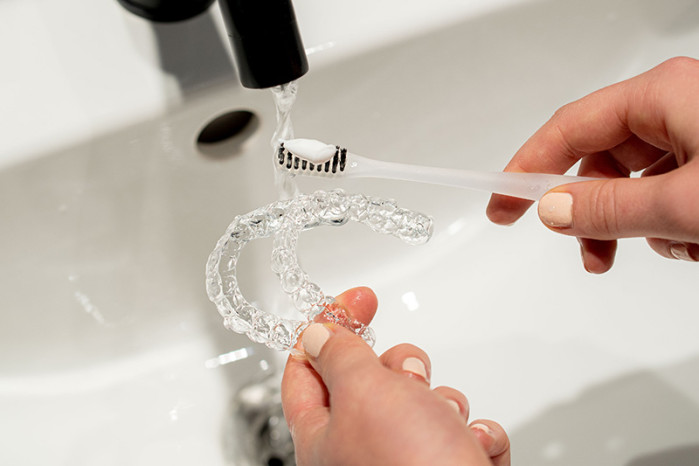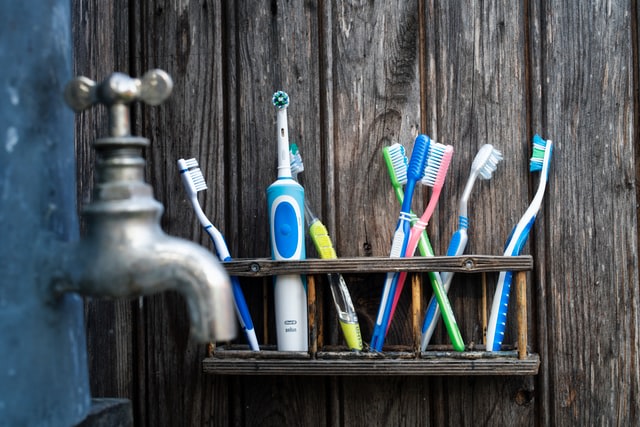Here, you will find some simple instructions for how to brush your teeth properly
DrSmile has put together a simple guide that explains exactly in which order you should brush your teeth to do it properly.

Here's how to brush your teeth properly
Place your toothbrush on your posterior teeth in the upper jaw at the gum line and begin to gently apply pressure by rotating the brush head. The bristles must be only allowed to bend slightly. Circling the brush head will cause plaque to be loosened from the teeth. In addition, the bristles will penetrate the interdental spaces.
Then move your toothbrush towards the chewing surface using a swiping motion.
This process must be repeated at least ten times in the same place.
Then you place your toothbrush on the outsides of your posterior teeth in the upper jaw. Close your mouth slightly at the same time, and carefully perform circular jiggling movements again.
You should repeat this process, from the teeth in your upper jaw to your molars.
Then you brush the outside surfaces of your lower jaw teeth following the same schema.
Now hold the brush head parallel to the inside surfaces of the upper teeth and start brushing them.
Finally, brush your chewing surfaces horizontally.
And, last but not least: How long and often should you brush your teeth? Ideally, you should brush your teeth twice a day, in the morning and in the evening, for about two to three minutes each time.

A large selection of toothbrushes: manual toothbrush, electric toothbrush or sonic toothbrush
If you want to brush your teeth with a manual toothbrush, the bristles should be rounded and should not consist of natural hair.
We recommend toothbrushes of a soft or medium hardness and with a short brush head. With a manual toothbrush, you can apply custom pressure to your gums and teeth, though you have to make sure you do not brush with too much pressure. You also have to make sure that you always clean the entire surface of the tooth.
Electric toothbrush
Brushing with an electric toothbrush is particularly gentle on tooth enamel and gums – this is an advantage, especially when it comes to sensitive teeth. The automatically rotating movement is a very convenient cleaning method that also cleans the oral cavity thoroughly.
An electric toothbrush consists of the following main components: a handpiece, onto which the brush head is attached, and a charging unit. The battery integrated in the handpiece drives an electric motor that generates the brush's movements.
The sonic toothbrush
The brush head of a sonic toothbrush glides more comfortably over your teeth because the frequency of the sonic toothbrush is very high.
It has different cleaning modes and intensity levels, which is why people with sensitive gums also like to use a sonic toothbrush.
A sonic toothbrush has a built-in rechargeable battery that, depending on the model, executes up to 62,000 vibrations per minute. The toothbrush achieves this extremely high frequency by working with a sound transducer instead of an electric motor. The vibrations generated are transmitted to the brush head. Some sonic toothbrushes have a deep cleaning function and a polishing function that can remove stains from the teeth.
You should change your toothbrush or brush head at regular intervals of every 2 to 3 months.

Protect your teeth from tooth decay with this toothpaste
With a fluoride-containing toothpaste, you can optimally care for your teeth and at the same time prevent tooth decay.
The fluoride that makes it onto your teeth from the toothpaste forms a protective layer of calcium fluoride around them. As a result, microorganisms or acids that get onto your teeth due to food intake are neutralised, and the minerals in the tooth enamel, as well as the tooth enamel itself, remain in tact.
Fluoride-free toothpaste cleans your teeth deeply and at the same time hardens the tooth enamel. With fluoride-free products, you can reduce the (small) risk of a fluoride overdose.
Why you should care for your interdental spaces as well as your teeth themselves
It is very important to clean your interdental spaces at least once a day. Often, there is stubborn plaque in the interdental spaces that you cannot reach with your toothbrush.
If these are not cleaned, food particles can get stuck in them, and bacteria can multiply quickly. This can lead to bleeding gums, bad breath and tooth decay.
The only way to clean the spaces between your teeth is to use dental floss or an interdental brush. These allow you to reach every hidden corner and to free your teeth from dental plaque and food residues.
You should use the tools gently in order to not injure your gums.
In addition, you can use mouthwashes in the evening that kill germs in the mouth and between the teeth.
How to properly care for sensitive gums
If you have sensitive gums that tend to bleed or swell quickly, consider using a sonic toothbrush with soft bristles. The right pressure is applied to your gums, so that you can care for them gently but precisely.
You should also use interdental brushes or dental floss every day in addition, to clean the spaces between your teeth.
If you have inflamed gums, you can use a mouthwash that accelerates tissue renewal and regeneration.
Lighten discolouration with natural home remedies
Discoloured teeth quickly appear neglected. But you don't necessarily have to consider a professional teeth whitening in a dental practice if you have slight discolouration.
Home remedies such as baking powder, baking soda or turmeric can help you to make your teeth shine again!
What to pay attention to when brushing your teeth if you have braces
If you have braces, you should take some special considerations into account when brushing your teeth. The toothbrush is particularly important. You should brush your teeth with a soft to medium-hard nylon bristle toothbrush, and then change it about every two months.
Your manual toothbrush should have a special orthodontic brush or short head, as they allow you to brush hard-to-reach areas better.
If you prefer to brush your teeth with an electric toothbrush, you should use special brush attachments for orthodontic patients. The smaller brush head has shorter, harder bristles in the middle and longer, softer bristles on the edge. In addition, you should make sure that your electric toothbrush not only vibrates, but rotates. The toothpaste you use should contain around 1500 ppm fluoride to harden the tooth enamel. You should also use fluoride gel once or twice a week.
Brushing your teeth properly if you smoke
As a smoker, you should definitely use a soft toothbrush to protect the gums that have been irritated by the tobacco.
You should also use a toothpaste that contains fluoride. A fluoride content of 1000 to 1500 ppm is ideal.
Fluoride strengthens tooth enamel and makes teeth more resistant to bacterial attacks and acids.
Here, again, it is particularly important to clean the spaces between the teeth with dental floss or an interdental brush.
You can also use a mouthwash with anti-bacterial ingredients such as chlorhexidine. It prevents inflammation and neutralizes bad breath. However, chlorhexidine can promote tooth discolouration.